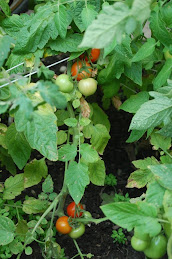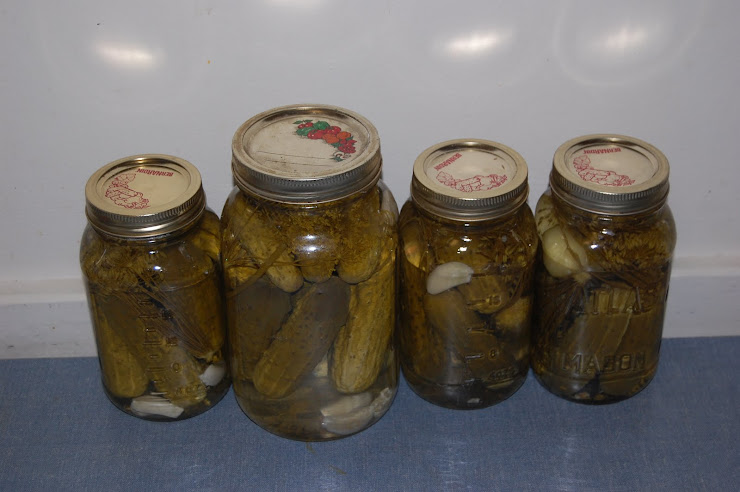
As usual the holidays were a blur and trying to eat SOLE and find time to blog about it proved to be an impossible dream. So I lost a few weeks and don't know what week I'm on any more. Since I did manage to cook a few things recently that encompassed the spirit if not the letter of the Dark Days Challenge I thought I'd do a quick update.
Post holiday eating is always a bit of a challenge. We've been oversaturated with rich food and haven't had time to shop for much in the way of fresh produce. And on top of that, the Sorauren market was on hiatus over the holidays so I've been missing my most ready available source of local ingredients. So I've been dependant on whatever we have in the freezer or pantry. Luckily both were fairly well stocked.
I made this dish based on something my mom used to make us when I was a child. I don't think it actually has a name but I jokingly refer to it as her fusion style because it has a base of her frugal Scots heritage mixed with elements of her French Canadian roots. In this case I used local smoked bacon and duck fat(I rendered myself) which we didn't have growing up but I'm sure Mom would approve.

1 leek, white and light green part, chopped
3 cups coursely chopped cabbage
1 med cooking onion chopped
1/2 cup of bacon cut in small pieces
1-2 tbsp duck or bacon fat
1/3 c maple syrup or to taste
 Melt fat in a cast iron or similar frying pan. Add bacon pieces and saute for about one minute on med heat(longer if you like your bacon crispy- I don't). Add all veggies and saute until soft,about 5-7 minutes. Add maple syrup, stir to coat evenly. Turn off heat and allow to rest so flavours mingle but sugars don't burn. Serve as a side or a meal on it's own (feeds 2).
Melt fat in a cast iron or similar frying pan. Add bacon pieces and saute for about one minute on med heat(longer if you like your bacon crispy- I don't). Add all veggies and saute until soft,about 5-7 minutes. Add maple syrup, stir to coat evenly. Turn off heat and allow to rest so flavours mingle but sugars don't burn. Serve as a side or a meal on it's own (feeds 2).I mentioned in my first Dark Days post that I have issues with maple syrup made in Ontario and I promised to expand. My mom's family is from Quebec, near Montreal and maple syrup is a way of life- my grandfather was known to eat it on everything from eggs to coffee. Sugaring off time is a big community celebration and the most treasured syrup is the first run. I've grown up with this as the ideal syrup and although I am born and raised in Ontario, when it comes to syrup, Quebec will always be my gold standard. Ontario syrup has two things against it for my tastes; darker syrup (which I think tastes like molasses) is far more popular here, and it's common here to tap species of maples other than sugar maples. It's for the latter reason that my grandmother always referred to Ontario syrup as "fencepost syrup"; in her mind they'd tap anything in Ontario!
I've found I'm not the only one with very stong opinions when it comes to maple syrup. I've even been accused of liking 'flatlander' syrup by a native Vermonter, which I found funny since my ideal syrup is produced high in the Laurentian mountains. Apparently the light grades in Vermont are sold only to tourists.
There are different standards, as well as grading scales for maple syrup in Canada and the US (Vermont has it's own). "In Canada, syrups must be at least 66 percent sugar and be made exclusively from maple sap to qualify as maple syrup. In the United States, a syrup must be made almost entirely from maple sap to be labelled as "maple"." (from Wikipedia).
In Canada, maple syrup comes in 3 grades and each grade has colour classes. Canada #1 is broken down into Extra Light (sometimes known as AA), Light (A), and Medium (B); Grade #2 is Amber (C); and Grade #3 is always Dark (D). In Ontario, Canada #2 Amber may be labelled "Ontario Amber" when produced and sold in that province only.
The United States only uses two major grades: Grade A and Grade B. Grade A is further divided into three subgrades: Light Amber (sometimes known as Fancy), Medium Amber, and Dark Amber.
The lightest syrup to me is the best because it has the appropriate sugar content without the strong mineral content that many people believe is the 'maple' taste. The darker syrups are produced later in the run and because the sugar content is lower they must be boiled longer to concentrate the sugars to the correct density. The last syrup produced in a season is sometimes jokingly referred to as the 'frog run' since it may be far enough into spring that you can here frogs croaking. A good syrup producer will stop tapping long before that; the sugar concentrations in sap are extremely low by the time the first buds begin to open. Anything darker than Light in my books isn't true syrup so I wait until I can receive my annual share from Quebec and then hoard it like liquid gold. The syrup pictured above it is the last bit left from last year's run and has darkened over time in the fridge but it still retains it's delicate flavour.
So call me a maple syrup snob if you will- I can live with it. Just don't try to serve me 'fencepost syrup'.

















.jpg)




Fencepost! Ha!
ReplyDeleteAlthough I must be a typical Ontarian - I do prefer the darker grades, especially for baking or on oatmeal. Pancakes or french toast though - must have light grade!
I've been trying to figure out how much I should get this year - while I have a small, local producer, they are still more than a 30 minute drive away, so it's not something I can just run out and get.
My parents tapped their own trees one year, and the result was EXCELLENT. They found it too much hassle though, and got rid of all the equipment :(
With Not far From the Tree we tapped Norway maples -the only tree the city allowed us to 'damage' according to city bylaws. Norways havea substantially lower sugar content so it took 70 L of sap to make a single litre of syrup but it still tasted pretty good. I'm sure my grandmother would disown me if she knew!
ReplyDeleteI love light No 1 syrup best. I find it hard to find the darker cooking grade and so my husband complains I spend too much on maple syrup.
ReplyDeleteMy Ontario syrup comes from a farm one road over from me and I know it's MAPLE syrup, so no fence post here!
Mm duck fat is delicious to cook with. You were lucky to get it.